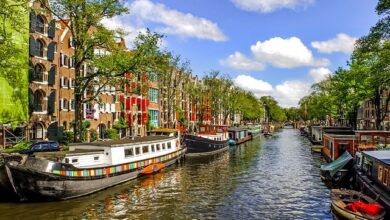A Guide to the Dutch Countryside and Windmills

The Netherlands is a country renowned for its picturesque landscapes, charming villages, and iconic windmills. Beyond the bustling cities like Amsterdam and Rotterdam lies a serene countryside dotted with tulip fields, canals, grazing cows, and historic windmills that evoke a sense of timeless beauty. This guide will take you on a journey through the Dutch countryside, exploring its natural wonders, cultural heritage, and the enduring legacy of windmills.
1. Discovering the Dutch Countryside
The Dutch countryside is a patchwork of lush green pastures, vibrant flower fields, and winding waterways. It’s a place where modernity meets tradition, offering visitors a glimpse into rural life in the Netherlands.
A. Must-Visit Regions
- Zaanse Schans : Located just north of Amsterdam, this open-air museum is home to well-preserved windmills, traditional wooden houses, and artisan workshops. It’s one of the best places to experience authentic Dutch culture.
- Giethoorn : Known as the “Dutch Venice,” Giethoorn is a car-free village crisscrossed by canals and footbridges. Explore the area by boat or bike for an unforgettable experience.
- Keukenhof Gardens : Visit during spring (March to May) to witness the world-famous tulip fields in full bloom. The Keukenhof estate showcases millions of flowers across 32 hectares.
- Hoge Veluwe National Park : A vast nature reserve featuring forests, heathlands, and sand dunes. Rent a free white bicycle to explore the park’s scenic trails.
- Waterland : Just outside Amsterdam, this region is characterized by quaint villages like Broek in Waterland and Monnickendam, where time seems to stand still.
B. Activities to Enjoy
- Cycling : The Netherlands boasts over 35,000 kilometers of cycling paths, making it easy to explore the countryside at your own pace.
- Boat Tours : Many rural areas are accessible only by water, so hop aboard a canal cruise or rent your own electric boat.
- Picnics : Pack a basket with local cheeses, stroopwafels, and fresh produce, and enjoy a meal surrounded by idyllic scenery.
- Photography : Capture the quintessential Dutch landscape—windmills against a backdrop of tulips, grazing sheep, and reflective canals.
2. The Iconic Dutch Windmills
Windmills are synonymous with the Netherlands, symbolizing the ingenuity and resilience of the Dutch people. Originally built to drain water from low-lying lands, they played a crucial role in shaping the country’s geography and economy.
A. History of Windmills
- Purpose : Windmills were first used in the Middle Ages to pump water out of polders (reclaimed land below sea level), grind grain, saw timber, and press oil.
- Golden Age : By the 17th century, there were over 10,000 windmills in the Netherlands. Today, around 1,000 remain, many preserved as national monuments.
- UNESCO Recognition : Several windmill sites, such as Kinderdijk, are UNESCO World Heritage Sites due to their historical significance.
B. Famous Windmill Locations
- Kinderdijk : This UNESCO-listed site features 19 beautifully preserved windmills dating back to the 18th century. They were part of a sophisticated water management system designed to prevent flooding.
- Schiedam : Home to the tallest windmills in the world, standing up to 40 meters high. These giants were once used for milling spices and grains.
- Zaanse Schans : Here, you’ll find working windmills dedicated to various crafts, including paint-making, mustard production, and lumber processing.
- Amsterdam Area : De Gooyer, located near Artis Zoo, is one of the last remaining windmills within the city limits.
C. Visiting Windmills
- Guided Tours : Many windmills offer guided tours where you can learn about their mechanics and history.
- Interactive Experiences : Some windmills allow visitors to climb inside to see how they operate.
- Seasonal Events : During National Mill Day (Nationale Molendag ), held annually in May, hundreds of windmills open their doors to the public for free.
3. Cultural Insights
The Dutch countryside isn’t just about windmills—it’s also steeped in rich traditions and customs.
A. Local Cuisine
- Stamppot : A hearty dish made from mashed potatoes mixed with vegetables like kale or carrots, often served with sausage.
- Herring : Fresh raw herring is a popular snack, typically eaten with onions and pickles.
- Cheese : The Netherlands is famous for its cheeses, especially Gouda, Edam, and Leiden. Visit a cheese market in Alkmaar or Gouda for a taste of tradition.
B. Festivals
- Tulip Festival : Celebrated in various towns during spring, this festival highlights the importance of tulips to Dutch agriculture and culture.
- Sinterklaas : In late November and early December, the arrival of Saint Nicholas is celebrated with parades and gift-giving.
C. Sustainability
The Dutch have long been pioneers in sustainable practices, using wind energy to power mills centuries ago. Today, the Netherlands continues to lead in renewable energy initiatives, blending old-world charm with modern innovation.
4. Tips for Exploring the Countryside
- Best Time to Visit : Spring (April to June) is ideal for seeing tulips in bloom, while summer offers warm weather perfect for outdoor activities.
- Transportation : Rent a bike or use regional trains to reach rural destinations easily.
- Accommodations : Stay in cozy bed-and-breakfasts, farm stays, or boutique hotels nestled in the countryside.
- Packing Essentials : Bring comfortable shoes for walking, a camera for capturing stunning views, and layers for unpredictable weather.


